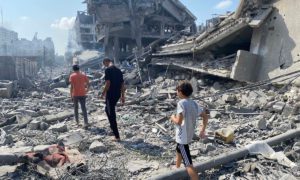Srinagar: Despite the lack of a designated space for art to foster in Kashmir, the artists here, established and budding, continue to paint the picture of the conflict-ridden valley and present it before the world.
This month, 14 artists from the valley transferred their lived experiences, through different media of art, as people born or affected by conflict to people who know nothing or only a little about it.
At South Asia’s largest and most influential contemporary Art Biennale in Kochi, Kerela the artists presented their work as an inclusive infra project ‘A place for repose.’
The curator for the project is Veer Munshi, a Kashmiri artist who now lives in Delhi.
The artists who were the part of the project were: Altaf Qadri, Ehtisham Azhar, Gargi Raina, Hina Aarif, Inder Salim, Khytul Abyad, Maumoon Ahmad, Mujtaba Rizvi, Neeraj Bakshy, Rajendar Tiku, Sanna Irshad Mattoo, Saqib Butt and Showkat Nanda and Veer Munshi.

The day started with a performance by Saqib and Hina who frisked the entrants with an idea to transfer their lived experience of frisking by the armed forces in the valley, on a daily basis.
Inside, the body of work of all other artists was displayed.
A symbolic shrine with eleven small coffins lying near it, sheep skin hung on a wall, pictures of women waiting for their beloveds to return; abandoned houses and shrines, a memoir and painting about the death of a crow were the artworks displayed in the Biennale.

Explaining the assembly Munshi says, “the whole idea was that I concede a Dargah which is a space where people from every circle comes. I built this 24×16 feet symbolic shrine.”
One of the artists from Kashmir, Khytul Abyad hails from Anantnaag which is known for its springs and hits the news for being one of the most volatile zones in the valley. “Khytul had gotten eleven water bottles with water from all the springs, except one which has dried out. She had labelled the bottle with the name of the place she had gotten the water from,” shares Munshi elaborating, “Anantnag is in South Kashmir which is a highly volatile place with people dying on a daily basis due to the conflict. The place is also about the pristine waters that people don’t know much about. It’s actually how you show a place known for blood also has waters flowing within.”
Another artist, Maumoon, had presented a drawing like that of a tree make of bones, says Munshi. “It is around 30 feet long.”
Photographs captured by valley’s renounced photojournalists including Showkat Nanda, Altaf Qadri and Syed Mujtaba Rizvi were also displayed as part of the project.

“Around 25 of Showkat’s black and white photographs about women who have been waiting for their missing beloveds, lost in the conflict were displayed. Altaf Qadri has beautifully captured the shrines in Kashmir and those photographs were also a part of our project. Rizvi’s photographs about children of conflict were also included,” says Munshi.
Performance artist Inder Salim had performed ‘SACRED HOME: Kyah Kare Yiman Panchan Dahan te Kahan’.
Artist Ehtisham Azhar who practices contemporary methodology in visual arts says, “I had placed ten sheepskin on a wall and around it were objects like oxygen cylinder, oxygen mask and a school chair. It is essentially brutal as it involves your different senses including the sense of smell with which you smell the sheepskin. It’s about death,” Ehtisham says. “Whose death is a different question,” he adds.

Further, says Munshi, Neeraj Bhakshy’s memoir, a book that he had written after going back to Kashmir where he has painted the picture of Kashmiri shrines, surroundings and households was also kept on display.
Gargi Raina, a Kashmiri artist living in Baroda at present, had painted ‘death of a crow’.
“It is around 15 feet long painting in which she has used charcoal medium. She has painted death of a crow which is also a symbol of a dark period,” Munshi says while talking about Gargi’s painting.
Rajender Tiku, from Jammu, had included relics of a shrine in a sculpture he has carved.
“Tiku is a performer. I had included a collage of his performance photographs as well,” says Munshi adding Hina’s personal photographs thinking about violence were also kept on display.

Sanna Mattoo, a photojournalist from Kashmir says that a part of her documentary based on a gravedigger, Habibullah Khan will be screened in the Biennale.
“It is heartbreaking, and the irony is that the interview is his first and last video interview. I had promised to get his word out. He had written a poem where he had wished to die and lie among the martyrs so he might as well enter the real paradise,” says Sanna.
“We cannot afford to lose our cultural space. Even if we acquire Azadi (freedom), without a cultural space, what kind of place would this be?” asks Munshi who and other artists see a hope in biennales like this which can make Kashmiri voices be heard globally.
Like this story? Producing quality journalism costs. Make a Donation & help keep our work going.






